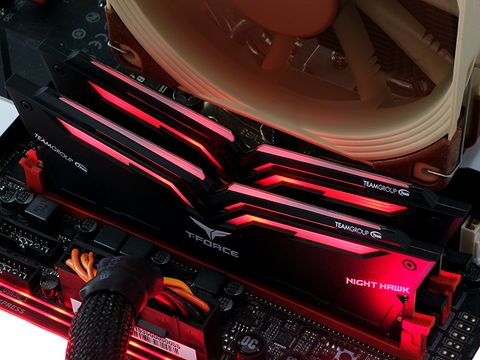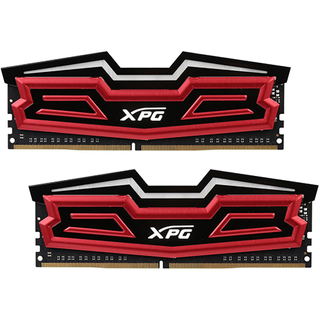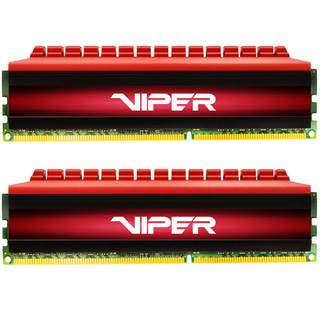Early Verdict
With its moderate price and good XMP performance, Team Group’s T-Force series Night Hawk DDR4-3000 offers better value to users of compatible (Z170 and Z270) platforms.
Pros
- +
Better-value pricing among LED-lit DRAM
- +
Excellent XMP Performance
Cons
- -
Poor overclocking capability
- -
LED-lit RAM still cost more than unlit RAM
Why you can trust Tom's Hardware
Introducing T-Force Night Hawk
Available at 2666, 2800, 3000, and 3200 MHz data rates, Team Group’s T-Force Nighthawk series brings LED lighting at moderate cost to buyers who want both performance and bling. The part numbers are easily deciphered once you’re told that the third letter represents lighting color. We received the red version, THRD416G3000HC16CDC01, and the same modules are available with blue LEDs as part number THBD416G3000HC16CDC01, or white LEDs as part number THWD416G3000HC16CDC01. Following the order within those part numbers, all three kits are DDR4, 16GB, with a 3000 MHz data rate, CAS 16 rating, designed for Dual-Channel operation. (Editor: There will be a test on this later.)
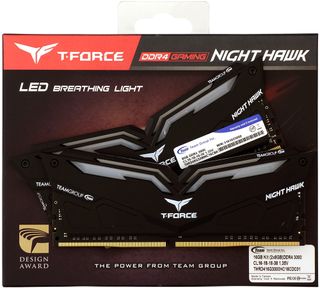
The lighting isn’t particularly bright, but it does show up better when viewed straight-on. The light diffusers on top for example appear more brightly-lit when viewed from that angle. The lighting cycles on and off in a breathing pattern that further dims its appearance in photographs.
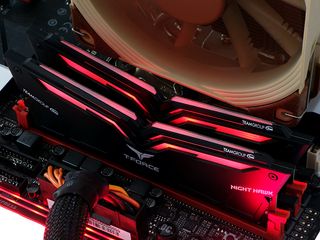
As with all DDR4-3000, getting to the rated data rate requires the installer to enable their motherboard’s XMP capability. Prior to doing that, motherboards detect these as JEDEC-standard DDR4-2133 CAS 15.

Like the two other 16GB dual-channel kits used for performance comparison, T-Force Nighthawk DDR4-3000 carries a manufacturer lifetime warranty.
Comparison Products
Gigabyte’s Z170X-Gaming G1 set the high mark for DDR4 overclocking in our Z170 review series, and remains the motherboard of choice as we search for its successor. The eventual successor will bring with it a new set of support hardware and software.
Test System Configuration
Benchmark Configuration
| Autodesk 3ds Max 2013 | Version 15.0 x64: Space Flyby Mentalray, 248 Frames, 1440x1080 |
|---|---|
| WinRAR | Version 5.0: THG-Workload (1.3 GB) to RAR, command line switches "winrar a -r -m3" |
| Grid 2 | Steam Version, In-Game Test, High Quality, No AA |
| Battlefield 4 | DirectX 11, 100-sec. Fraps "Tashgar", High Quality |
| SiSoftware Sandra | Version 2014.02.20.10, Memory Bandwidth, Cache & Memory Latency Benchmarks |
MORE: Best Memory
MORE: DDR DRAM FAQs And Troubleshooting Guide
MORE: All Memory Content
-
_TheD0ct0r_ Can you guys start adding Canadian links to the product as well? It would be appreciated by Canadian usersReply -
Nei1 Well, Canadian links. But it would be most helpful if we'd all simply up and go to Canada. That's taking into consideration that "up" is North, and would also help reduce latency.Reply -
mikeangs2004 feel free to message the editors directly and don't get too far off topic or irrelevant to the original reviewReply -
reghir Thomas there seems to be an issue reported earlier this month, see below:Reply
3 out of 5 eggs
If only it met it's own specs
This review is from: Team T-Force / Night Hawk 16GB (2 x 8GB) 288-Pin DDR4 SDRAM DDR4 3000 (PC4 24000) Memory (Desktop Memory) Model THBD416G3000HC16CDC01
Pros: - It booted up!
- Working at 2800 Mhz
Cons: - LED's on them are dull
- Won't actually work at 3000Mhz as advertised. Even when using XMP.
Other Thoughts: Setup:
Gigabyte GA-Z170X-Gaming 7
i7 6700K 4Ghz
16GB Team T-Force/Night Hawk DDR4 3000
Gigabyte Windforce NVidia GTX970
Manufacturer Response:
Hello,
We are so sorry to hear the problem you encountered with. Right now, we are using the same platform as yours to test on our RAM to find out the possible causes of this issue. We will let you know our test result and guide you to the next step.
Thank you for your patience.
Team Group -
Crashman Reply
I could only guess. Maybe he's having trouble running the 15x multiplier. I'd personally rather use DDR4-3200, but only because it uses 12x 4/3 x 100 and the lower multipliers work with more CPU samples. But then again, maybe the 4/3 memory controller ratio isn't ideal, performance wise...19213793 said:Thomas there seems to be an issue reported earlier this month, see below:
3 out of 5 eggs
If only it met it's own specs
This review is from: Team T-Force / Night Hawk 16GB (2 x 8GB) 288-Pin DDR4 SDRAM DDR4 3000 (PC4 24000) Memory (Desktop Memory) Model THBD416G3000HC16CDC01
Pros: - It booted up!
- Working at 2800 Mhz
Cons: - LED's on them are dull
- Won't actually work at 3000Mhz as advertised. Even when using XMP.
Other Thoughts: Setup:
Gigabyte GA-Z170X-Gaming 7
i7 6700K 4Ghz
16GB Team T-Force/Night Hawk DDR4 3000
Gigabyte Windforce NVidia GTX970
Manufacturer Response:
Hello,
We are so sorry to hear the problem you encountered with. Right now, we are using the same platform as yours to test on our RAM to find out the possible causes of this issue. We will let you know our test result and guide you to the next step.
Thank you for your patience.
Team Group
-
razor512 I don't get why RAM with LEDs cost so much more. It probably costs them less than 10 cents to add lighting to them, as if you are going with a fixed color, you can literally just tap off one of the power rails on the RAM, and solder in an LED or 2, and then if needed, attach some plastic to them to diffuse the light a bit.Reply -
Crashman Reply
It's probably closer to $1, because they also need to have the new heatsinks and light covers manufactured, including the injection molds for the covers. But then there's the failure rate to consider, that adds cost as well.19222893 said:I don't get why RAM with LEDs cost so much more. It probably costs them less than 10 cents to add lighting to them, as if you are going with a fixed color, you can literally just tap off one of the power rails on the RAM, and solder in an LED or 2, and then if needed, attach some plastic to them to diffuse the light a bit.
-
WINTERLORD Reply19224175 said:
It's probably closer to $1, because they also need to have the new heatsinks and light covers manufactured, including the injection molds for the covers. But then there's the failure rate to consider, that adds cost as well.19222893 said:I don't get why RAM with LEDs cost so much more. It probably costs them less than 10 cents to add lighting to them, as if you are going with a fixed color, you can literally just tap off one of the power rails on the RAM, and solder in an LED or 2, and then if needed, attach some plastic to them to diffuse the light a bit.
by doing this does it take away from possable performance
